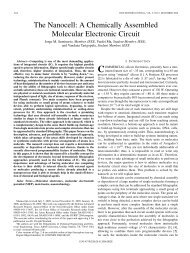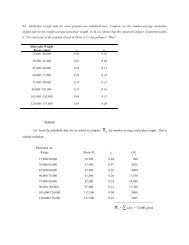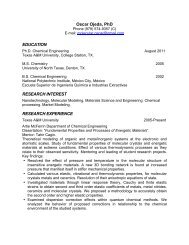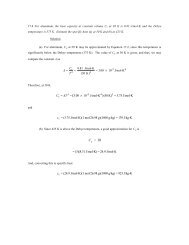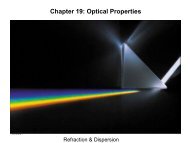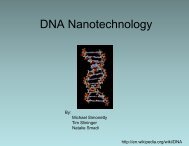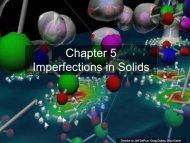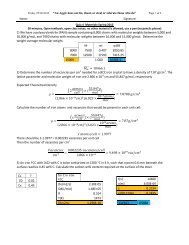Atomic structure, bonding
Atomic structure, bonding
Atomic structure, bonding
Create successful ePaper yourself
Turn your PDF publications into a flip-book with our unique Google optimized e-Paper software.
Chapter 2: <strong>Atomic</strong> Structure & Interatomic Bonding<br />
These notes have been prepared by Jorge Seminario from the textbook material<br />
1
• Basic idea … properties of materials are a<br />
consequence of<br />
– Identity of the atoms<br />
– Spatial arrangement of the atoms<br />
– Interactions between the atoms<br />
• Thus, we need to study atomic <strong>structure</strong>/<strong>bonding</strong>!
Chapter 2: <strong>Atomic</strong> Structure &<br />
Interatomic Bonding<br />
ISSUES TO ADDRESS...<br />
• What promotes <strong>bonding</strong>?<br />
• What types of bonds are there?<br />
• What properties are inferred from <strong>bonding</strong>?
2.2 <strong>Atomic</strong> Structure (Freshman Chem.)<br />
• atom – electrons – 9.11 x 10 -31 kg<br />
protons<br />
} neutrons 1.67 x 10 -27 kg<br />
• atomic number = # of protons in nucleus of atom<br />
= # of electrons of neutral species<br />
• A [=] atomic mass unit = amu = 1/12 mass of 12 C<br />
<strong>Atomic</strong> wt = wt of 6.022 x 10 23 molecules or atoms<br />
C 12.011<br />
H 1.008 etc.<br />
1 amu/atom = 1g/mol<br />
4
<strong>Atomic</strong> Structure<br />
• Some of the following properties<br />
1) Chemical<br />
2) Electrical<br />
3) Thermal<br />
4) Optical<br />
are determined by electronic <strong>structure</strong>
2.2 Fundamental Concepts<br />
• Atoms consist of a small nucleus<br />
containing<br />
• Protons<br />
+1.60 x 10 -19 C = e<br />
1.67 x 10 -27 kg<br />
• Neutrons<br />
0 C (neutral)<br />
1.67 x 10 -27 kg<br />
• Electrons (which circle the<br />
nucleus)<br />
-1.60 x 10 -19 C = -e<br />
9.11 x 10 -31 kg
2.2 Fundamental Concepts<br />
• <strong>Atomic</strong> Number (Z)<br />
• Number of protons in the nucleus<br />
• Electrically neutral or complete<br />
atom: Z = # electrons<br />
• <strong>Atomic</strong> Mass (A)<br />
• Sum of the masses of protons and<br />
neutrons; atomic mass unit = amu =<br />
1/12 mass of 12 C<br />
• Isotopes<br />
• Atoms of the same element with<br />
different atomic masses due to varying<br />
number of neutrons (e.g. 12 C, 13 C, 14 C
Basic concepts<br />
– Atoms are made of protons, neutrons and electrons<br />
• m e = 0.00091094x10 -27 = 9.1094x10 -31 kg = 0.511 MeV<br />
• m p = 1.6726 x 10 -27 kg = 938.272 MeV<br />
• m n = 1.6749 x 10 -27 kg = 939.566 MeV = m p + 1.293 MeV<br />
– Charge of a proton and electron are the same: 1.6022x10 -19 C<br />
– However p are +’ve and e are –’ve<br />
– Since J = C x V (1 joule = 1 coulomb x 1 volt),<br />
1 eV = 1.6022x10 -19 J<br />
– mass is related to energy by E = mc 2
2.3 Electrons In Atoms<br />
Bohr <strong>Atomic</strong> Model<br />
• Early outgrowth of<br />
quantum mechanics<br />
• Electrons revolve<br />
around nucleus in<br />
discrete orbitals<br />
• Electrons closer to<br />
nucleus travel faster<br />
then outer orbitals<br />
• Principal quantum<br />
number (n); 1 st shell,<br />
n=1; 2 nd shell, n=2;<br />
3 rd shell, n=3
c02f02<br />
Quantum Numbers<br />
For the H atom<br />
Scaled for<br />
hydrogen-like<br />
atoms<br />
Degenerate states<br />
Same energy
Bohr Atom<br />
Wave-mechanical atom<br />
c02f03
<strong>Atomic</strong> Models<br />
• Wave-Mechanical<br />
Model<br />
• Electron exhibits both<br />
wave-like and particle-like<br />
characteristics<br />
• Position is now considered<br />
to be the probability of an<br />
electron being at various<br />
locations around the<br />
nucleus, forming an<br />
electron cloud
Electron Configuration<br />
• Pauli Exclusion Principle<br />
• Stipulates that electron states (orbital or shell) can have no<br />
more than two electrons, must have opposite spins<br />
• Ground state<br />
• All electrons occupy the lowest energies<br />
• Electrons can move to higher states<br />
• Filled shells are more stable
Electronic Structure<br />
• Electrons have wave-like and particle-like properties (old view)<br />
• We can better say that the wave-particle nature is the real<br />
thing; individual wave and particle states are limiting cases,<br />
observed in measurements (collapse of the wave function)<br />
• To better understand electronic <strong>structure</strong>, we assume<br />
– Electrons “reside” in orbitals.<br />
– Each orbital, at a discrete energy level, is determined by<br />
quantum numbers.<br />
c<br />
Quantum numbers<br />
n = principal (energy level-shell)<br />
Designation<br />
K, L, M, N, O (1, 2, 3, etc.)<br />
l = angular (orbitals) s, p, d, f (0, 1, 2, 3,…, n -1)<br />
m l = magnetic<br />
m s = spin ½, -½<br />
1, 3, 5, 7 (-l to +l)<br />
14
c\2f04<br />
Quantum Numbers<br />
Relative electrons<br />
energies (E) for shells<br />
and subshells<br />
if n↓ then E↓<br />
Within each shell E↑<br />
with quantum number<br />
Overlapping in energy<br />
of a state in one shell<br />
with states in adjacent<br />
shells, true of d and f<br />
states
c02tf01
Electron Configurations<br />
• Valence electrons – those in unfilled shells<br />
• Filled shells more stable<br />
• Valence electrons are most available for<br />
<strong>bonding</strong> and tend to control the chemical<br />
properties<br />
– example: C (atomic number = 6)<br />
1s 2 2s 2 2p 2<br />
valence electrons<br />
17
<strong>Atomic</strong> Models<br />
Quantum numbers<br />
• Principal quantum number n, represents a<br />
shell<br />
• K, L, M, N, O correspond to n=1, 2, 3, 4,<br />
5....<br />
• Quantum number l, signifies the subshell<br />
• Lowercase italics letter s, p, d, f; related to<br />
the shape of the subshell<br />
• Quantum number m l<br />
, represents the<br />
number of energy states<br />
• s, p, d, f have 1, 3, 5, 7 states respectively<br />
• Quantum number m s<br />
, is the spin moment<br />
• Each electron is a spin moment<br />
• (+1/2) and (-1/2)
Electron Configuration<br />
Silicon (Si)<br />
• Electron configuration<br />
represents the manner in<br />
which the states are<br />
occupied<br />
• Valence electrons<br />
• Occupy the outermost<br />
shell<br />
• Available for <strong>bonding</strong><br />
• Tend to control chemical<br />
properties
Electron Configurations - Pauli Exclusion Principle<br />
c02f05<br />
Na Atom<br />
Z = 11
c02tf02<br />
When some elements covalently<br />
bond, they form sp hybrid bonds,<br />
e.g., C, Si, Ge
Examples<br />
Give the electron configurations for the following:<br />
C<br />
1s 2 2s 2 2p 2<br />
Br<br />
1s 2 2s 2 2p 6 3s 2 3p 6 4s 2 3d 10 4p 5<br />
Mn +2<br />
1s 2 2s 2 2p 6 3s 2 3p 6 3d 5<br />
F - 1s 2 2s 2 2p 6<br />
Cr<br />
1s 2 2s 2 2p 6 3s 2 3p 6 4s 1 3d 5
Electronic Configurations<br />
ex: Fe - atomic # = 26<br />
1s 2 2s 2 2p 6 3s 2 3p 6 3d 6 4s 2<br />
4d<br />
4p<br />
3d<br />
4s<br />
N-shell n = 4<br />
valence<br />
electrons<br />
Energy<br />
3p M-shell n = 3<br />
3s<br />
2p<br />
2s<br />
Adapted from Fig. 2.4,<br />
Callister & Rethwisch 3e.<br />
L-shell n = 2<br />
1s<br />
K-shell n = 1<br />
Notice that 2s and 2p do not have the same energy<br />
23
Electron Configuration<br />
• “Stable electron configurations”<br />
• States within the outermost or valence electron shell are<br />
completely filled<br />
• Some atoms of elements with unfilled shells assume<br />
stable electron configurations by gaining or losing<br />
electrons to form charged ions<br />
• Sometimes s and p orbitals form hybrid sp n orbitals<br />
• 3A, 4A, and 5A group elements typically<br />
• Lower energy state for the valence electrons
SURVEY OF ELEMENTS<br />
• Most elements: Electron configuration not stable.<br />
Element<br />
Hydrogen<br />
Helium<br />
Lithium<br />
Beryllium<br />
Boron<br />
Carbon<br />
...<br />
Neon<br />
Sodium<br />
Magnesium<br />
Aluminum<br />
...<br />
Argon<br />
...<br />
Krypton<br />
<strong>Atomic</strong> #<br />
1<br />
2<br />
3<br />
4<br />
5<br />
6<br />
10<br />
11<br />
12<br />
13<br />
18<br />
...<br />
36<br />
Electron configuration<br />
1s 1<br />
1s 2<br />
(stable)<br />
1s 2 2s 1<br />
1s 2 2s 2<br />
1s 2 2s 2 2p 1<br />
1s 2 2s 2 2p 2<br />
...<br />
1s 2 2s 2 2p 6 (stable)<br />
1s 2 2s 2 2p 6 3s 1<br />
1s 2 2s 2 2p 6 3s 2<br />
1s 2 2s 2 2p 6 3s 2 3p 1<br />
...<br />
1s 2 2s 2 2p 6 3s 2 3p 6 (stable)<br />
...<br />
1s 2 2s 2 2p 6 3s 2 3p 6 3d 10 4s 2 4p 6 (stable)<br />
Adapted from Table 2.2,<br />
Callister & Rethwisch 3e.<br />
25
STABLE ELECTRON CONFIGURATIONS<br />
Stable electron configurations...<br />
• have complete s and p subshells<br />
• tend to be unreactive.<br />
Adapted from Table 2.2,<br />
Callister 6e.<br />
4
2.4 Periodic Table<br />
• Elements classified according to electron configuration<br />
• Elements in a given column or group have similar valence electron<br />
<strong>structure</strong>s as well as chemical and physical properties<br />
• Group 0 – inert gases, filled shells and stable<br />
• Group VIIA – halogen<br />
• Group IA and IIA - alkali and alkaline earth metals<br />
• Groups IIIB---IIB – transition metals<br />
• Groups IIIA, IVA and VA – characteristics between the metals and<br />
nonmetals
2.4
Electronegativity Values<br />
• Electropositive:<br />
• Capable of giving up their<br />
valence electrons to become<br />
positively charged<br />
• Electronegative:<br />
• Readily accept electrons to form<br />
negatively charged ions<br />
• Sometimes share electrons with<br />
other atoms
<strong>Atomic</strong> Bonding<br />
• Valence electrons determine all of the<br />
following properties<br />
1) Chemical<br />
2) Electrical<br />
3) Thermal<br />
4) Optical<br />
5) Deteriorative<br />
6) etc.<br />
30
<strong>Atomic</strong> Bonding in Solids
When 0 = F A + F R ,<br />
equilibrium exists.<br />
The centers of the<br />
atoms will remain<br />
separated by the<br />
equilibrium spacing<br />
r o .<br />
2.5 Bonding Forces and<br />
Energies<br />
This spacing also<br />
corresponds to the<br />
minimum of the<br />
potential energy<br />
curve. The energy<br />
that would be<br />
required to<br />
separate two<br />
atoms to an infinite<br />
separation is E o<br />
F N = F A + F R<br />
Figure 2.8<br />
E N = E A + E R
2.5 Bonding Forces and Energies<br />
• A number of material properties depend on E o ,<br />
the curve shape, and <strong>bonding</strong> type<br />
– Material with large E o typically have higher melting<br />
points<br />
– Mechanical stiffness is dependent on the shape of its<br />
force vs. interatomic separation curve (F vs r)<br />
– A material’s linear coefficient of thermal expansion<br />
is related to the shape of its E vs. r curve
Bonding in Solids<br />
• 2.5 Bonding forces and energies<br />
– Far apart: atoms don’t know about each other<br />
– As they approach one another, start to exert force on one<br />
another<br />
• two types of forces<br />
– Attractive (F A ) – slowly changing with distance<br />
– Repulsive (F R ) – typically short-range<br />
– Net force is the sum of these<br />
F N = F A + F R<br />
– At some point the net force is zero; at that position a state of<br />
equilibrium exists
Bonding forces and energies<br />
F<br />
E<br />
E<br />
dE<br />
F <br />
dr<br />
F A<br />
F R<br />
N<br />
N<br />
<br />
<br />
r<br />
<br />
<br />
E<br />
F<br />
A<br />
A<br />
<br />
dr<br />
E<br />
<br />
R<br />
r<br />
<br />
<br />
F<br />
R<br />
Bonding in Solids<br />
dr<br />
E<br />
<br />
The interatomic separation at that point (r o ) corresponds<br />
to the potential energy at that minimum<br />
E o , it is also the <strong>bonding</strong> energy<br />
E o is the energy needed to separate the atoms<br />
<br />
Fdr<br />
<br />
<br />
r<br />
<br />
Fdr<br />
& setting our ZERO ENERGY reference at ∞<br />
<br />
<br />
r<br />
<br />
Fdr<br />
The point where the forces<br />
are zero also corresponds<br />
to the minimum potential<br />
energy for the two atoms,<br />
which makes sense because<br />
-dE/dr = F = 0 at a minimum.
Examples<br />
(book wrong sign of the F)<br />
Calculate the force of attraction between ions X + and an Y - , the<br />
centers of which are separated by a distance of 2.01 nm.<br />
&
2.6 Primary Interatomic Bonds<br />
• Types of chemical bonds found in solids<br />
– Ionic<br />
– Covalent<br />
– Metallic<br />
• As you might imagine, the type of <strong>bonding</strong> influences<br />
properties – why?<br />
• Bonding involves the valence electrons!!!
2.6 Primary Interatomic Bonds<br />
• Ionic Bonding<br />
– Compounds composed of metallic and nonmetallic<br />
elements<br />
– Coulombic Attractive Forces: positive and negative ions,<br />
by virtue of their net electrical charge, attract one another<br />
• E A = -A/r<br />
• E R = B/r n<br />
Coulombic <strong>bonding</strong> Force<br />
A, B, n are<br />
Cl<br />
Na<br />
constants -<br />
+<br />
– Bonding is nondirectional: the magnitude of the bond is<br />
equal in all directions around an ion<br />
– Properties: generally large <strong>bonding</strong> energies (600-1500<br />
kJ/mol) and thus high melting temperatures, hard, brittle,<br />
and electrically and thermally insulative
c02f09<br />
2.6 Primary Interatomic Bonds
2.6 Primary Interatomic Bonds<br />
• Ionic <strong>bonding</strong><br />
– Prototype example – sodium chloride (NaCl)<br />
• Sodium gives up one its electrons to chlorine – sodium becomes<br />
positively charged, chlorine becomes negatively charged<br />
– The attraction energy is electrostatic in nature in ionic solids<br />
(opposite charges attract)<br />
– The attractive component of the potential energy (for 2 point<br />
charges) is given by<br />
– The repulsive term is given by<br />
E<br />
E<br />
A<br />
R<br />
<br />
<br />
<br />
B<br />
n<br />
r<br />
Z eZ<br />
e<br />
1 2<br />
<br />
4<br />
o<br />
1<br />
r<br />
, n ~ 8 12
Ionic bond: metal + nonmetal<br />
donates<br />
electrons<br />
accepts<br />
electrons<br />
Dissimilar electronegativities<br />
ex: MgO Mg 1s 2 2s 2 2p 6 3s 2 O 1s 2 2s 2 2p 4<br />
[Ne] 3s 2<br />
Mg 2+ 1s 2 2s 2 2p 6 O 2- 1s 2 2s 2 2p 6<br />
[Ne]<br />
[Ne]<br />
41
Ionic Bonding<br />
• Occurs between + and - ions.<br />
• Requires electron transfer.<br />
• Large difference in electronegativity required.<br />
• Example: NaCl<br />
Na (metal)<br />
unstable<br />
electron<br />
Cl (nonmetal)<br />
unstable<br />
Na (cation)<br />
stable<br />
+ -<br />
Coulombic<br />
Attraction<br />
Cl (anion)<br />
stable<br />
42
Ionic Bonding<br />
• Energy – minimum energy most stable<br />
– Energy balance of attractive and repulsive terms<br />
E N = E A + E R =<br />
<br />
A<br />
r<br />
<br />
B<br />
r n<br />
Repulsive energy E R<br />
Interatomic separation r<br />
Net energy E N<br />
Adapted from Fig. 2.8(b),<br />
Callister & Rethwisch 3e.<br />
Attractive energy E A<br />
43
Examples: Ionic Bonding<br />
• Predominant <strong>bonding</strong> in Ceramics<br />
NaCl<br />
MgO<br />
CaF 2<br />
CsCl<br />
Give up electrons<br />
Acquire electrons<br />
Adapted from Fig. 2.7, Callister & Rethwisch 3e. (Fig. 2.7 is adapted from Linus Pauling, The Nature of the<br />
Chemical Bond, 3rd edition, Copyright 1939 and 1940, 3rd edition. Copyright 1960 by Cornell University.<br />
44
2.6 Primary Interatomic Bonds<br />
• Covalent Bonding<br />
– Stable electron configurations are assumed by<br />
the sharing of electrons between adjacent atoms<br />
– Bonding is directional: between specific atoms<br />
and may exist only in the direction between one<br />
atom and another that participates in electron<br />
sharing<br />
– Number of covalent bonds for a particular<br />
molecule is determined by the number of<br />
valence electrons<br />
– Bond strength ranges from strong to weak<br />
• Rarely are compounds purely ionic or<br />
covalent but are a percentage of both.<br />
Sharing 2<br />
electrons<br />
Sharing<br />
4<br />
electrons<br />
%ionic character = {1 – exp[-(0.25)(X A -X B ) 2 ]} x 100<br />
X A and X B are electronegatives
Covalent <strong>bonding</strong><br />
– Sharing of electrons between adjacent atoms<br />
– Most nonmetallic elements and molecules containing<br />
dissimilar elements have covalent bonds<br />
– Polymers!<br />
– Bonding is highly directional!<br />
– Number of covalent bonds possible is guessed by the<br />
number of valence electrons<br />
• Typically is 8 – N, where N is the number of valence<br />
electrons<br />
• Carbon has 4 valence e’s – 4 bonds (ok!)
H<br />
2.1<br />
Li<br />
1.0<br />
Na<br />
0.9<br />
K<br />
0.8<br />
Rb<br />
0.8<br />
Cs<br />
0.7<br />
Fr<br />
0.7<br />
EXAMPLES: COVALENT BONDING<br />
Be<br />
1.5<br />
Mg<br />
1.2<br />
Ca<br />
1.0<br />
Sr<br />
1.0<br />
Ba<br />
0.9<br />
Ra<br />
0.9<br />
H2<br />
Ti<br />
1.5<br />
Cr<br />
1.6<br />
Fe<br />
1.8<br />
H2O<br />
C(diamond)<br />
SiC<br />
Ni<br />
1.8<br />
Zn<br />
1.8<br />
Ga<br />
1.6<br />
column IVA<br />
C<br />
2.5<br />
Si<br />
1.8<br />
As<br />
2.0<br />
GaAs<br />
Adapted from Fig. 2.7, Callister 6e. (Fig. 2.7 is<br />
adapted from Linus Pauling, The Nature of the Chemical Bond, 3rd edition, Copyright<br />
1939 and 1940, 3rd edition. Copyright 1960 by Cornell University.<br />
Ge<br />
1.8<br />
Sn<br />
1.8<br />
Pb<br />
1.8<br />
O<br />
2.0<br />
F<br />
4.0<br />
Cl<br />
3.0<br />
Br<br />
2.8<br />
I<br />
2.5<br />
At<br />
2.2<br />
He<br />
-<br />
Ne<br />
-<br />
Ar<br />
-<br />
Kr<br />
-<br />
Xe<br />
-<br />
Rn<br />
-<br />
F2<br />
Cl2<br />
• Molecules with nonmetals<br />
• Molecules with metals and nonmetals<br />
• Elemental solids (RHS of Periodic Table)<br />
• Compound solids (about column IVA)<br />
11
Covalent Bonding<br />
• similar electronegativity share electrons<br />
• bonds determined by valence – s & p orbitals<br />
dominate <strong>bonding</strong><br />
• Example: CH 4<br />
shared electrons<br />
C: has 4 valence e - ,<br />
needs 4 more<br />
CH 4<br />
H<br />
from carbon atom<br />
H: has 1 valence e - ,<br />
needs 1 more<br />
Electronegativities<br />
are comparable.<br />
H<br />
C<br />
H<br />
H<br />
shared electrons<br />
from hydrogen<br />
atoms<br />
Adapted from Fig. 2.10, Callister & Rethwisch 3e.<br />
48
Bonding in Solids<br />
• Many materials have <strong>bonding</strong> that is both ionic and<br />
covalent in nature (very few materials actually exhibit pure<br />
ionic or covalent <strong>bonding</strong>)<br />
• Easy (empirical) way to estimate % of ionic <strong>bonding</strong><br />
character:<br />
%ionic character<br />
<br />
<br />
<br />
2<br />
1exp<br />
(0.25)(<br />
X ) x<br />
100<br />
A<br />
X B<br />
X A , X B are the electronegativities of atoms A and B involved<br />
Notice: this is a very very very empirical formula
Primary Bonding<br />
• Ionic-Covalent Mixed Bonding<br />
% ionic character =<br />
x ( 100 %)<br />
where X A & X B are Pauling electronegativities<br />
<br />
Ex: MgO X Mg = 1.3<br />
X O = 3.5<br />
<br />
1 e (X AX B ) 2 <br />
<br />
<br />
4<br />
<br />
<br />
<br />
<br />
<br />
<br />
(3.5<br />
<br />
% ionic character 1<br />
e 4<br />
<br />
<br />
1.3)<br />
2<br />
<br />
<br />
<br />
<br />
<br />
x (100%) <br />
70.2%ionic<br />
50
Example<br />
Compute the percentage ionic character of the interatomic bond for<br />
zinc oxide (ZnO). Refer to the periodic Table for electronegativity<br />
values. Note: Electronegativity values in slides differ slightly from<br />
those in book.<br />
% ionic character = {1-exp[-(0.25)*(X Zn -X O ) 2 ]}*100<br />
= {1-exp[-(0.25)*(1.7-3.5) 2 ]}*100<br />
= 55.51%
2.6 Primary Interatomic Bonds<br />
• Metallic Bonding<br />
– Found in metals and their alloys<br />
– 1 to 3 valence electrons that form a<br />
“sea of electrons” or an “electron<br />
cloud” because they are more or<br />
less free to drift through the entire<br />
metal<br />
– Nonvalence electrons and atomic<br />
nuclei form ion cores<br />
– Bonding energies range from weak<br />
to strong<br />
– Good conductor of both electricity<br />
and heat<br />
– Most metals and their alloys fail in<br />
a ductile manner<br />
+<br />
+<br />
+<br />
Ion<br />
Cores<br />
+<br />
- -<br />
+<br />
- -<br />
+<br />
Sea of Valence<br />
Electrons<br />
+<br />
+<br />
+
METALLIC BONDING<br />
• Arises from a sea of donated valence electrons<br />
(1, 2, or 3 from each atom).<br />
Adapted from Fig. 2.11, Callister 6e.<br />
• Primary bond for metals and their alloys<br />
12
• Metallic <strong>bonding</strong><br />
Bonding in Solids<br />
– Most metals have one, two, or at most three valence electrons<br />
– These electrons are highly delocalized from a specific atom – have<br />
a “sea of valence electrons”<br />
– Free electrons shield positive core of<br />
ions from one another (reduce E R )<br />
– Metallic <strong>bonding</strong> is also nondirectional<br />
– Free electrons also act to hold<br />
<strong>structure</strong> together<br />
– Wide range of <strong>bonding</strong> energies,<br />
typically good conductors (why?)
2.7 Secondary Bonding or van der<br />
Walls Bonding<br />
• Also known as physical bonds<br />
• Weak in comparison to primary or chemical<br />
bonds<br />
• Exist between virtually all atoms and molecules<br />
• Arise from atomic or molecular dipoles<br />
– <strong>bonding</strong> that results from the coulombic attraction<br />
between the positive end of one dipole and the<br />
negative region of an adjacent one<br />
– a dipole may be created or induced in an atom or<br />
molecule that is normally electrically symmetric
2.7 Secondary Bonding or van der<br />
Waals Bonding<br />
• Fluctuating Induced Dipole Bonds<br />
– A dipole (whether induced or instantaneous)<br />
produces a displacement of the electron distribution<br />
of an adjacent molecule or atom and continues as a<br />
chain effect<br />
– Liquefaction and solidification of inert gases<br />
– Weakest Bonds<br />
– Extremely low boiling and melting point<br />
<strong>Atomic</strong> nucleus<br />
Electron<br />
cloud<br />
Instantaneous<br />
Fluctuation<br />
<strong>Atomic</strong> nucleus<br />
Electron<br />
cloud
2.7 Secondary Bonding or van der Waals Bonding<br />
• Polar Molecule-Induced Dipole Bonds<br />
– Permanent dipole moments exist by virtue of an<br />
asymmetrical arrangement of positively and negatively<br />
charged regions<br />
– Polar molecules can induce dipoles in adjacent nonpolar<br />
molecules<br />
– Magnitude of bond greater than for fluctuating induced<br />
dipoles<br />
+ -<br />
<strong>Atomic</strong> nucleus<br />
Electron Cloud<br />
Polar<br />
Molecule<br />
Induced<br />
Dipole
2.7 Secondary Bonding or van der<br />
Waals Bonding<br />
• Permanent Dipole Bonds<br />
– Stronger than any secondary <strong>bonding</strong> with induced<br />
dipoles<br />
– A special case of this is hydrogen <strong>bonding</strong>: exists<br />
between molecules that have hydrogen as one of the<br />
constituents<br />
Hydrogen Bond<br />
H Cl H Cl
Permanent dipoles<br />
Hydrogen-bonds<br />
These interactions are fairly strong, very<br />
complex, and surprisingly not well understood!<br />
van der Waals<br />
interactions between<br />
polar molecules<br />
2.82 Å<br />
109.47°<br />
Best known example<br />
hydrogen <strong>bonding</strong>
c02tf03
MATERIAL OF IMPORTANCE<br />
Water<br />
Many molecules do not have a<br />
symmetric distribution/arrangement<br />
of positive and negative charges<br />
(e.g. H 2 O, HCl)<br />
c02f16
c02uf01



